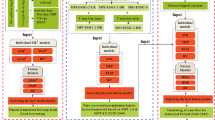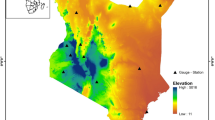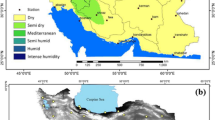Abstract
The examination and integration of numerical forecast products are essential for using and developing numerical forecasts and hydrological forecasts. In this paper, the control forecast products from 2010 to 2014 of four model data (China Meteorological Administration (CMA), the National Centers for Environmental Prediction (NCEP), the European Centre for Medium-Range Weather Forecasts (ECMWF), and the United Kingdom Meteorological Office (UKMO)) from The Interactive Grand Global Ensemble (TIGGE) data center were evaluated comprehensively. On this basis, a study of runoff forecasting based on multi-model (multiple regression (MR), random forest (RF), and convolutional neural network-gradient boosting decision tree (CNN-GBDT)) precipitation integration is carried out. The results show that the CMA model performs the worst, while the other models have their advantages and disadvantages in different evaluation indexes. Compared with the single-index optimal model, CMA model had a higher root-mean-square error (RMSE) of 18.4%, and a lower determination coefficient (R2) of 14.7%, respectively. The integration of multiple numerical forecast information is better than that of a single model, and CNN-GBDT method is superior to the multiple regression method and random forest method in improving the precision of rainfall forecast. Compared with the original model, the RMSE decreases by 13.1 ~ 27.9%, PO decreases to 0.538 at heavy rainfall, and the R2 increases by 4 ~ 15.2%, but the degree of improvement decreases gradually with the increase in rainfall order. The method of multi-model ensemble rainfall forecasting based on a machine learning model is feasible and can improve the accuracy of short-term rainfall forecasting. The runoff forecast based on multi-model precipitation integration has been improved, and NSE increases from 0.88 to 0.935, but there is still great uncertainty about flood peaks during the flood season.










Similar content being viewed by others
Data availability
TIGGE database used in this study in a 24-h lead time (https://conflfluence.ecmwf.int/display/TIGGE). TIGGE (The Interactive Grand Global Ensemble) is part of the THORPEX project, which is an initiative of the World Weather Research Programme (WWRP).
References
Abdolmanafi A, Saghafian B, Aminyavari S (2021) Evaluation of global ensemble prediction models for forecasting medium to heavy precipitations. Meteorology and Atmospheric Physics [j] 133:15–26. https://doi.org/10.1007/S00703-020-00731-8
Albawi S, Mohammed TA, Al-Zawi S (2017) Understanding of a convolutional neural network. In: International conference on engineering and technology (ICET). Ieee, pp. 1–6
Aminyavari S, Saghafian B (2019) Probabilistic Streamflow Forecast Based On Spatial Post-Processing Of Tigge Precipitation Forecasts. Stoch Environ Res Risk Assess 33:1939–1950. https://doi.org/10.1007/S00477-019-01737-4
Aminyavari S, Saghafian B, Sharifi E (2019) Assessment of precipitation estimation from the NWP models and satellite products for the spring 2019 severe floods In Iran. Remote Sens 11:2741. https://doi.org/10.3390/Rs11232741
Ba H, Guo S, Zhong Y et al (2019) Comparative study on probabilistic ensemble flood forecasting considering precipitation forecasts for the three Gorges reservoir. Adv Water Sci 30:186–197
Bao H, Zhao L (2012) Flood forecast of Huaihe river based on Tigge ensemble predictions. J Hydraulic Eng 43:216–224
Barnes C, Brierley CM, Chandler RE (2019) New Approaches To Integration Of Multi-Model Ensemble Forecasts. Q J R Meteorol Soc 145:3479–3498. https://doi.org/10.1002/Qj.3632
Bhomia S, Jaiswal N, Kishtawal CM (2017) Accuracy assessment of rainfall prediction by global models during the landfall of tropical cyclones in the North Indian ocean. Meteorol Appl 24:503–511. https://doi.org/10.1002/Met.1649
Bougeault P, Toth Z, Bishop C et al (2010) The thorpex interactive grand global ensemble. Bull Am Meteorol Soc 91:1059–1072. https://doi.org/10.1175/2010bams2853.1
Breiman L (2001) Random forests. Mach Learn 45:5–32. https://doi.org/10.1023/A:1010933404324
Cai C, Wang J, Li Z (2018) Improving Tigge precipitation forecasts using an SVR ensemble approach in the Huaihe river basin. Adv Meteorol. https://doi.org/10.1155/2018/7809302
Chen S, Wang Y, Yuan H (2013) Analysis of South China rainstorm in June 2008 and evaluation of Tigge forecasting. J Meteorol Sci 33:384–390
Cheng S, Qiao X, Shi Y et al (2021) Machine learning for predicting discharge fluctuation of a Karst spring In North China. Acta Geophys 69:257–270. https://doi.org/10.1007/S11600-020-00522-0
Courbariaux M, Barbillon P, Perreault L et al (2019) Post-processing multiensemble temperature and precipitation forecasts through an exchangeable normal-gamma model and its Tobit extension. J Agri Biol Environ Stat 24:309–345. https://doi.org/10.1007/S13253-019-00358-2
Da Silva FP, Da Silva AS, Da Silva MGAJ et al (2022) Assessment of WRF numerical model forecasts using different lead time initializations during extreme precipitation events over Macae City, Rio De Janeiro (Brazil). Nat Hazards 110:695–718. https://doi.org/10.1007/S11069-021-04964-7
Danandeh Mehr A (2021) Seasonal rainfall hindcasting using ensemble multi-stage genetic programming. Theor Appl Climatol 143:461–472. https://doi.org/10.1007/S00704-020-03438-3
Dehghani R, Poudeh HT, Younesi H et al (2020) Daily streamflow prediction using support vector machine-artificial flora (Svm-Af) hybrid model. Acta Geophys 68:1763–1778. https://doi.org/10.1007/S11600-020-00472-7
Friedman JH (2001) greedy function approximation: a gradient boosting machine. Ann Stat 29:1189–1232. https://doi.org/10.1214/Aos/1013203451
Gholizadeh R, Yilmaz H, Mehr AD (2022) Multitemporal meteorological drought forecasting using Bat-ELM. Acta Geophys 70:917–927. https://doi.org/10.1007/S11600-022-00739-1
Gu J, Wang Z, Kuen J et al (2018) Recent advances in convolutional neural networks. Pattern Recognit 77:354–377
Hagedorn R, Buizza R, Hamill TM et al (2012) Comparing Tigge multimodel forecasts with reforecast-calibrated ECMWF ensemble forecasts. Q J R Meteorol Soc 138:1814–1827. https://doi.org/10.1002/Qj.1895
Hamill TM, Scheuerer M (2018) Probabilistic precipitation forecast integration using quantile mapping and rank-weighted best-member dressing. Monthly Weather Rev 146:4079–4098. https://doi.org/10.1175/Mwr-D-18-0147.1
He Y, Wetterhall F, Cloke HL et al (2009) Tracking the uncertainty in flood alerts driven by grand ensemble weather predictions. Meteorol Appl 16:91–101. https://doi.org/10.1002/Met.132
He Y, Wetterhall F, Bao H et al (2010) Ensemble forecasting using Tigge for the July-September 2008 floods in the upper Huai catchment: a case study. Atmos Sci Lett 11:132–138. https://doi.org/10.1002/Asl.270
Herrera MA, Szunyogh I, Tribbia J (2016) Forecast uncertainty dynamics in the Thorpex interactive grand global ensemble (Tigge). Mon Weather Rev 144:2739–2766. https://doi.org/10.1175/Mwr-D-15-0293.1
Huang L, Luo Y (2017) Evaluation of quantitative precipitation forecasts by Tigge ensembles for South China during the presummer rainy. J Geophys Res Atmos 122:8494–8516. https://doi.org/10.1002/2017jd026512
Jha SK, Shrestha DL, Stadnyk TA et al (2018) Evaluation of ensemble precipitation forecasts generated through post-processing in a Canadian catchment. Hydrol Earth System Sci 22:1957–1969. https://doi.org/10.5194/Hess-22-1957-2018
Keller JH, Jones SC, Evans JL et al (2011) Characteristics of the Tigge multimodel ensemble prediction system in representing forecast variability associated with extratropical transition. Geophys Res Lett. https://doi.org/10.1029/2011gl047275
Krasnopolsky V, Lin Y (2012) A neural network nonlinear multimodel ensemble to improve precipitation forecasts over continental US. Adv Meteorol. https://doi.org/10.1155/2012/649450
Lagasio M, Parodi A, Pulvirenti IL et al (2019) A synergistic use of a high-resolution numerical weather prediction model and high-resolution earth observation products to improve precipitation forecast. Remote Sens. https://doi.org/10.3390/Rs11202387
Li W, Pan B, Xia J et al (2022) Convolutional neural network-based statistical post-processing of ensemble precipitation forecasts. J Hydrol 605:127301
Liu J, Xie Z (2014) BMA probabilistic quantitative precipitation forecasting over the Huaihe Basin using Tigge multimodel ensemble forecasts. Mon Weather Rev 142:1542–1555. https://doi.org/10.1175/Mwr-D-13-00031.1
Liu L, Gao C, Xuan W et al (2017) Evaluation of medium-range ensemble flood forecasting based on calibration strategies and ensemble methods in Lanjiang basin, Southeast China. J Hydrol 554:233–250. https://doi.org/10.1016/J.Jhydrol.2017.08.032
Liu Y, Zhang T, Duan H et al (2021) Evaluation of forecast performance for four meteorological models in summer over Northwestern China. Front Earth Sci. https://doi.org/10.3389/Feart.2021.771207
Liu J, Yuan X, Zeng J et al (2022) Ensemble streamflow forecasting over a cascade reservoir catchment with ensemble hydrometeorological modeling and machine learning. Hydrol Earth System Sci 26:265–278. https://doi.org/10.5194/Hess-26-265-2022
Loken ED, Clark AJ, Mcgovern A et al (2019) Integration next-day ensemble probabilistic precipitation forecasts using random forests. Weather Forecast 34:2017–2044 (Http://Dx.Doi.Org/10.1175/Waf-D-19-0109.1)
Louvet S, Sultan B, Janicot S et al (2016) Evaluation of Tigge precipitation forecasts over West Africa at intraseasonal timescale. Climate Dyn 47:31–47. https://doi.org/10.1007/S00382-015-2820-X
Medina H, Tian D, Marin FR et al (2019) Comparing Gefs, Ecmwf, and integration methods for ensemble precipitation forecasts over Brazil. J Hydrometeorol 20:773–790. https://doi.org/10.1175/Jhm-D-18-0125.1
Pappenberger F, Bartholmes J, Thielen J et al (2008) New dimensions in early flood warning across the globe using grand-ensemble weather predictions. Geophys Res Lett. https://doi.org/10.1029/2008gl033837
Park Y-Y, Buizza R, Leutbecher M (2008) Tigge: preliminary results on comparing and combining ensembles. Q J R Meteorol Soc 134:2029–2050. https://doi.org/10.1002/Qj.334
Qi H, Zhi X, Peng T et al (2019) Comparative study on probabilistic forecasts of heavy rainfall in mountainous areas of the Wujiang river basin In China based on Tigge data. Atmosphere. https://doi.org/10.3390/Atmos10100608
Qian Q, Jia X, Lin H et al (2021) Seasonal forecast of nonmonsoonal winter precipitation over the Eurasian continent using machine-learning models. J Climate 34:7113–7129. https://doi.org/10.1175/Jcli-D-21-0113.1
Qu B, Zhang X, Pappenberger F et al (2017) Multi-model grand ensemble hydrologic forecasting in the Fu river basin using Bayesian model averaging. Water 9:74. https://doi.org/10.3390/W9020074
Saedi A, Saghafian B, Moazami S et al (2020) Performance evaluation of sub-daily ensemble precipitation forecasts. Meteorol Appl. https://doi.org/10.1002/Met.1872
Sagar SK, Rajeevan M, Rao SVB et al (2017) Prediction skill of rainstorm events over India in the Tigge weather prediction models. Atmos Res 198:194–204. https://doi.org/10.1016/J.Atmosres.2017.08.017
Scher S, Messori G (2021) Ensemble methods for neural network-based weather forecasts. J Adv Model Earth Syst. https://doi.org/10.1029/2020ms002331
Shahdad M, Saber B (2022) Drought forecasting using new advanced ensemble-based models of reduced error pruning tree. Acta Geophys 70:697–712. https://doi.org/10.1007/S11600-022-00738-2
Swinbank R, Kyouda M, Buchanan P et al (2016) The Tigge project and its achievements. Bull Am Meteorol Soc 97:49–67. https://doi.org/10.1175/Bams-D-13-00191.1
Wu J, Lu G, Wu Z (2014) Flood forecasts based on multi-model ensemble precipitation forecasting using a coupled atmospheric-hydrological modeling system. Nat Hazards 74:325–340. https://doi.org/10.1007/S11069-014-1204-6
Zhang Y, Ye A (2021) machine learning for precipitation forecasts integration: multimodel comparison and experimental investigation. J Hydrometeorol 22:3065–3085. https://doi.org/10.1175/Jhm-D-21-0096.1
Zhao RJ (1992) The Xinanjiang model applied in China. J Hydrol 135:371–381. https://doi.org/10.1016/0022-1694(92)90096-E
Zhi X, Chen W (2010) New Achieveme Ts of international atmospheric research in Thorpex program. Trans Atmos Sci 33:504–511
Zhi X, Qi H, Bai Y et al (2012) A comparison of three kinds of multimodel ensemble forecast techniques based on the Tigge data. Acta Meteorol Sinica 26:41–51. https://doi.org/10.1007/S13351-012-0104-5
Zhi X, Ji X, Zhang J et al (2013) Multimodel ensemble forecasts of surface air temperature and precipitation using Tigge datasets. Trans Atmos Sci 36:257–266
Zsoter E, Pappenberger F, Smith P et al (2016) building a multimodel flood prediction system with the Tigge archive. J Hydrometeorol 17:2923–2940. https://doi.org/10.1175/Jhm-D-15-0130.1
Acknowledgements
The authors would like to acknowledge the financial support received from Projects of the National Natural Science Foundation of China (51979250), National key research priorities program of China (2016YFC040240203), Key projects of National Natural Science Foundation of China (51739009) and Key Research and Promotion Projects (technological development) in Henan Province (202102310587). This work is based on TIGGE data. TIGGE (The Interactive Grand Global Ensemble) is an initiative of the World Weather Research Programme (WWRP).
Funding
Projects of National Natural Science Foundation of China: Key technology study on flooding forecasting driven by intensive data in the middle reaches of Yellow watershed (51979250); Key projects of National Natural Science Foundation of China: Research on Theory and Method of Urban Flood Forecasting and Early Warning Based on Big Data (51739009); Key Research and Promotion Projects in Henan Province: Study on flood forecasting technology by deep learning based on water droplet migration path.
Author information
Authors and Affiliations
Contributions
YT, QW and CH: involved in conceptualization; YT and XL: contributed to methodology; YT and YS: involved in analysis; YT: contributed to writing—original draft; YT and SS: contributed to writing—review and editing; CH: involved in supervision.
Corresponding author
Ethics declarations
Conflict of interest
The authors declare that there is no conflict of interest regarding the publication of this paper.
Additional information
Edited by Dr. Ankit Garg (ASSOCIATE EDITOR) / Dr. Michael Nones (CO-EDITOR-IN-CHIEF).
Rights and permissions
Springer Nature or its licensor holds exclusive rights to this article under a publishing agreement with the author(s) or other rightsholder(s); author self-archiving of the accepted manuscript version of this article is solely governed by the terms of such publishing agreement and applicable law.
About this article
Cite this article
Tang, Y., Wu, Q., Soomro, Seh. et al. Comparison of different ensemble precipitation forecast system evaluation, integration and hydrological applications. Acta Geophys. 71, 405–421 (2023). https://doi.org/10.1007/s11600-022-00877-6
Received:
Accepted:
Published:
Issue Date:
DOI: https://doi.org/10.1007/s11600-022-00877-6




